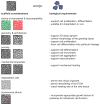Stem cell- and scaffold-based tissue engineering approaches to osteochondral regenerative medicine
- PMID: 19508851
- PMCID: PMC2737137
- DOI: 10.1016/j.semcdb.2009.03.017
Stem cell- and scaffold-based tissue engineering approaches to osteochondral regenerative medicine
Abstract
In osteochondral tissue engineering, cell recruitment, proliferation, differentiation, and patterning are critical for forming biologically and structurally viable constructs for repair of damaged or diseased tissue. However, since constructs prepared ex vivo lack the multitude of cues present in the in vivo microenvironment, cells often need to be supplied with external biological and physical stimuli to coax them toward targeted tissue functions. To determine which stimuli to present to cells, bioengineering strategies can benefit significantly from endogenous examples of skeletogenesis. As an example of developmental skeletogenesis, the developing limb bud serves as an excellent model system in which to study how osteochondral structures form from undifferentiated precursor cells. Alongside skeletal formation during embryogenesis, bone also possesses innate regenerative capacity, displaying remarkable ability to heal after damage. Bone fracture healing shares many features with bone development, driving the hypothesis that the regenerative process generally recapitulates development. Similarities and differences between the two modes of bone formation may offer insight into the special requirements for healing damaged or diseased bone. Thus, endogenous fracture healing, as an example of regenerative skeletogenesis, may also inform bioengineering strategies. In this review, we summarize the key cellular events involving stem and progenitor cells in developmental and regenerative skeletogenesis, and discuss in parallel the corresponding cell- and scaffold-based strategies that tissue engineers employ to recapitulate these events in vitro.
Figures




References
-
- Shum L, Coleman CM, Hatakeyama Y, Tuan RS. Morphogenesis and dysmorphogenesis of the appendicular skeleton. Birth Defects Research Part C - Embryo Today: Reviews. 2003;69:102–22. - PubMed
-
- Mackie EJ, Ahmed YA, Tatarczuch L, Chen KS, Mirams M. Endochondral ossification: How cartilage is converted into bone in the developing skeleton. International Journal of Biochemistry and Cell Biology. 2008;40:46–62. - PubMed
-
- Dawson JI, Oreffo ROC. Bridging the regeneration gap: Stem cells, biomaterials and clinical translation in bone tissue engineering. Archives of Biochemistry and Biophysics. 2008;473:124–31. - PubMed
-
- Gerstenfeld LC, Cullinane DM, Barnes GL, Graves DT, Einhorn TA. Fracture healing as a post-natal developmental process: Molecular, spatial, and temporal aspects of its regulation. Journal of Cellular Biochemistry. 2003;88:873–84. - PubMed
Publication types
MeSH terms
Substances
Grants and funding
LinkOut - more resources
Full Text Sources
Other Literature Sources
Medical
Research Materials

